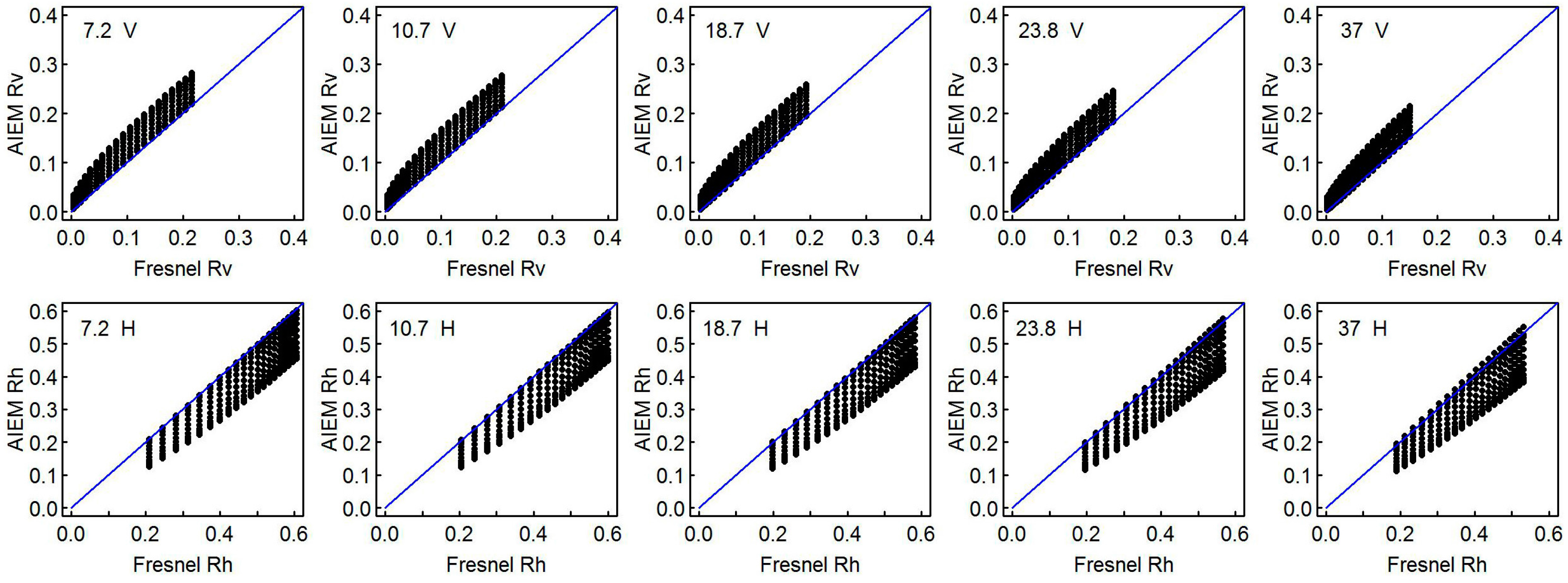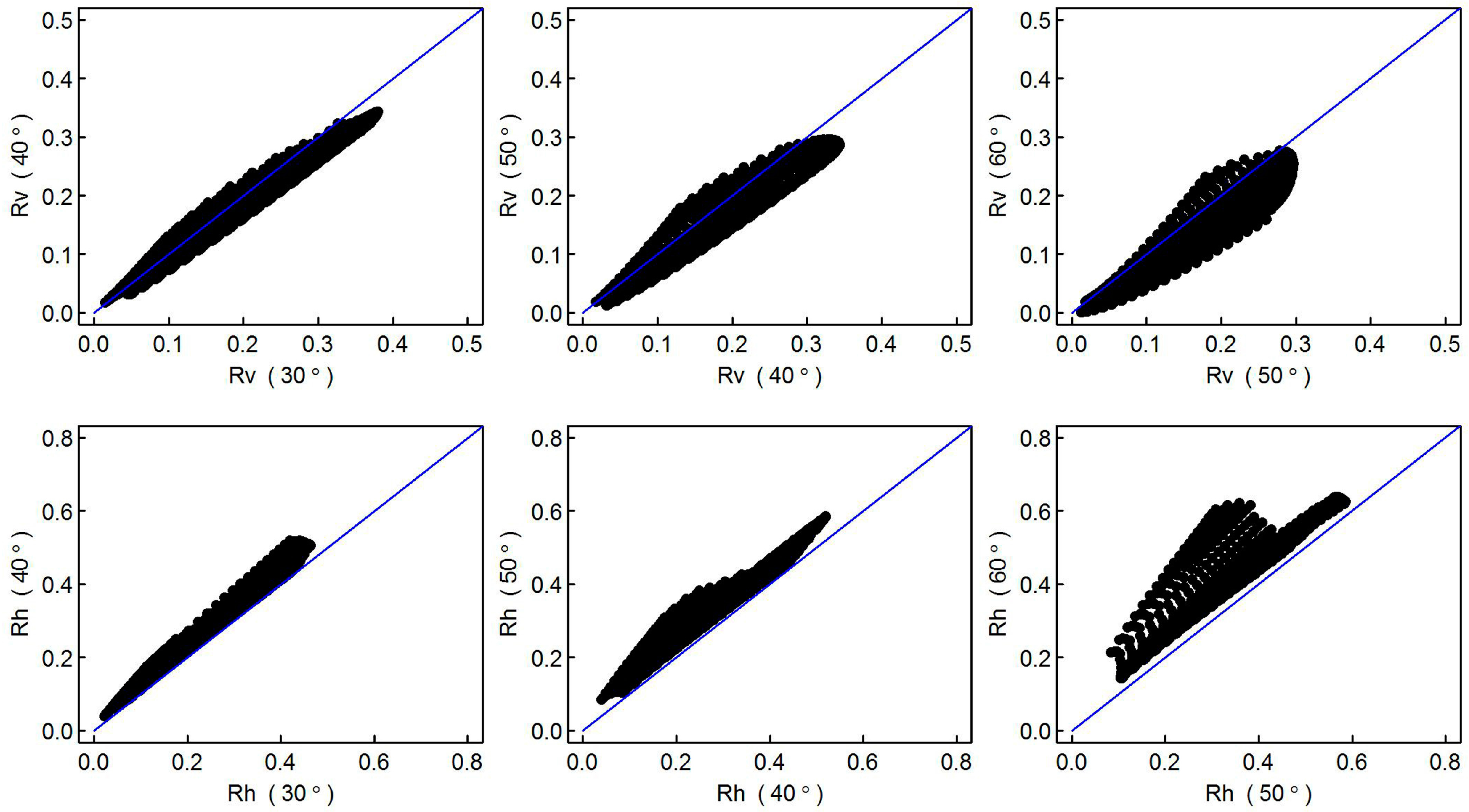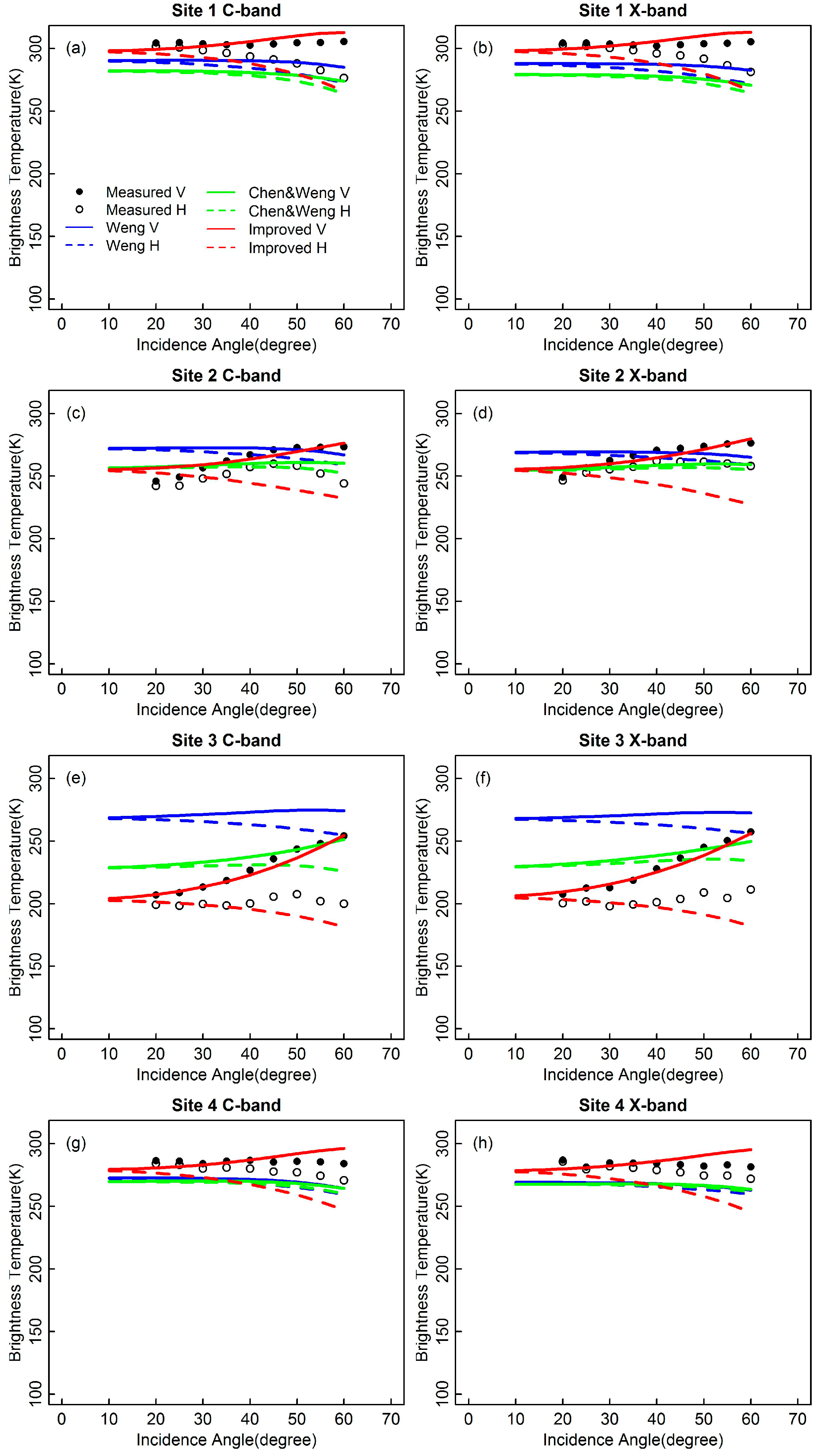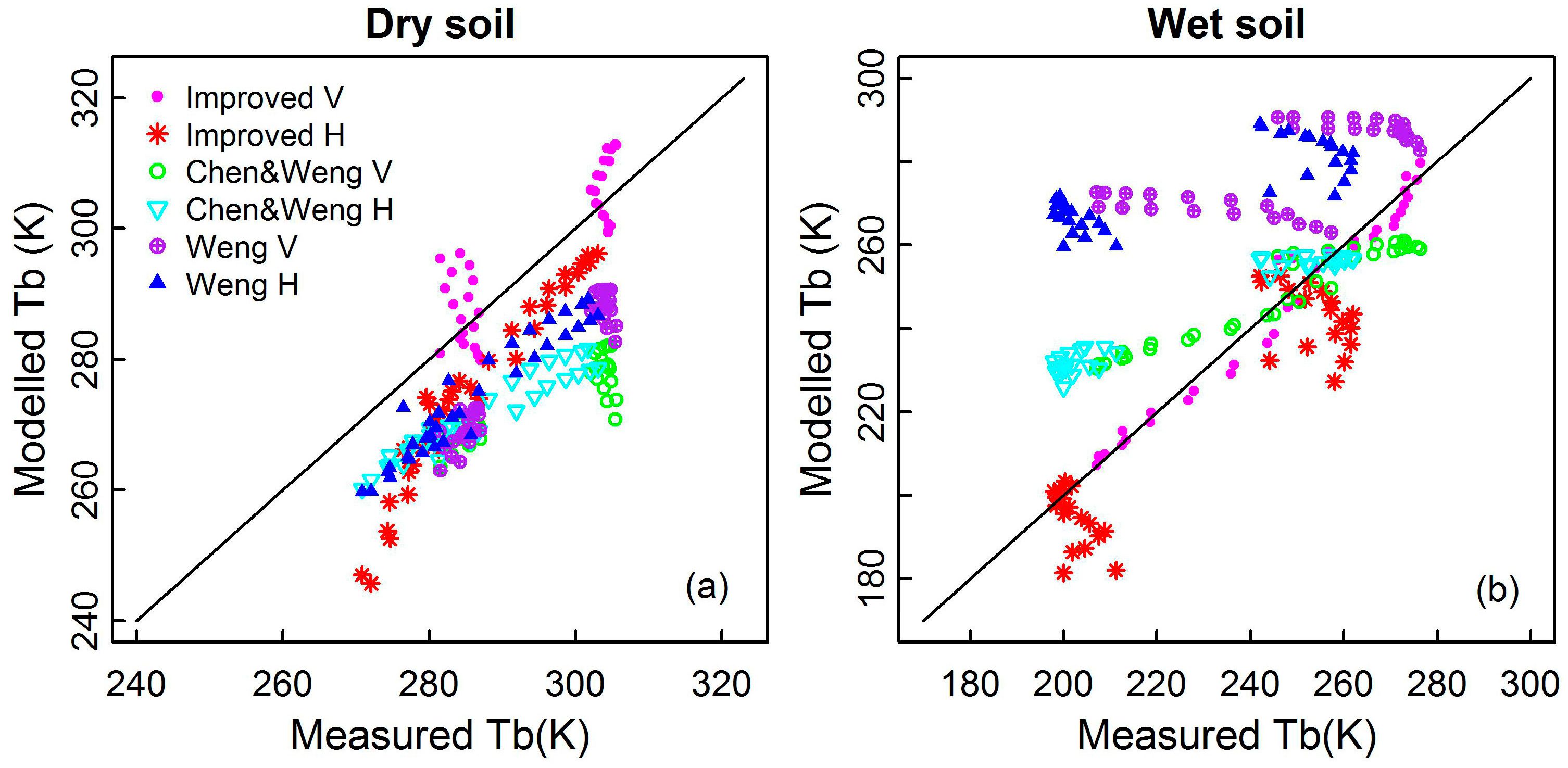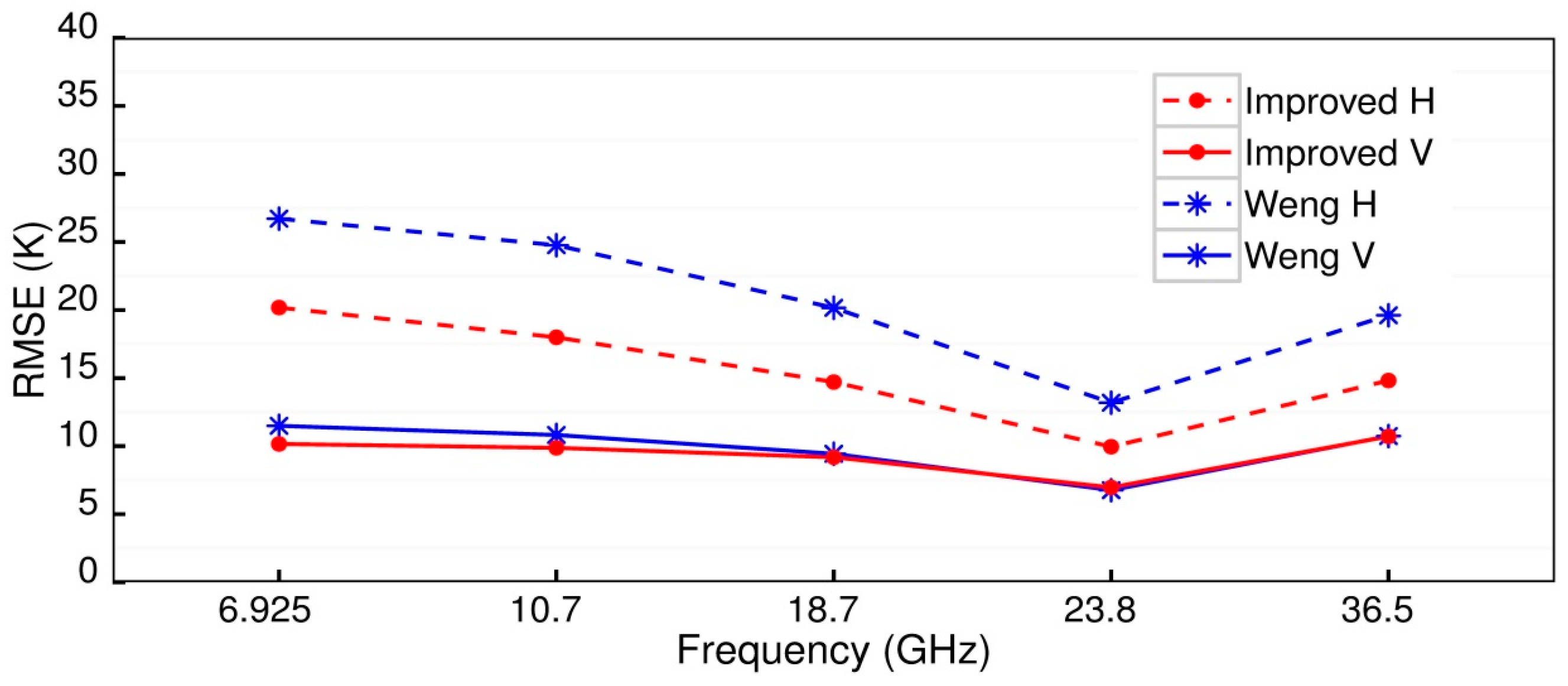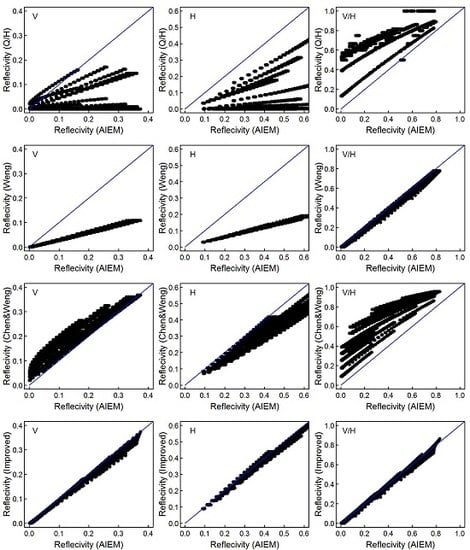1. Introduction
Satellite-based passive microwave remote sensing has been shown to be increasingly valuable in understanding the land-to-atmosphere fluxes of energy and water. Currently, with the development of remote sensing and data assimilation techniques, satellite measurements from microwave sounding can provide atmospheric temperature and moisture profiles under nearly all weather conditions, particularly over oceans, which has made significant contributions to improving the skill of numerical weather prediction (NWP) [
1]. The measurements obtained over land are strongly affected by the variability of surface emissions and its spectra, which are largely unknown over different surfaces. Due to the uncertainty in estimating microwave emissivity, problems remain in using passive microwave satellite data over land [
1,
2,
3,
4,
5].
Microwave emission signals from soil surfaces depend on their reflective and scattering properties. For a perfectly smooth (specular) soil surface, the reflectivity can be described by Fresnel equations. Over a naturally rough soil surface, the effective reflectivity or emissivity is generally associated with physical conditions, such as the surface roughness, soil ingredients in terms of dielectric permittivity, and soil texture [
2,
6]. Scattering by rough surface elements is a key factor in determining microwave surface emissivity. A number of previous studies have demonstrated the significant effect of surface roughness on soil emission [
2,
4,
5,
7,
8]. The soil’s dielectric permittivity is a common indicator of the soil moisture content (SMC), which also plays an essential role in estimating the microwave emissivity of the soil surface [
9,
10,
11]. The ability of soil moisture to be measured depends on the depth of soil moisture to which the microwave sensors actually respond [
9], and it also strongly depends on the band used within the microwave spectrum [
12,
13,
14]. Soil moisture between 0 and 1 cm depth from the surface has a more direct correlation with microwave emissivity, particularly for high-frequency microwave signals [
9]. The observed microwave brightness temperatures near the window regions (spectral regions of penetrating the atmosphere) are significantly affected by soil surface emissivity. An uncertainty of 5%–10% from soil surface emissivity can produce an uncertainty in brightness temperature data of a variation of a few dozen degrees [
15]. Therefore, accurate modeling of emissivity from soil surfaces is important for various application studies.
Various approaches to estimate the microwave emissivity of soil surfaces have been developed. The microwave emissivity of rough soil surfaces has been simulated in two types of models. The first type is a physical model, which yields a simulation based on its physical relationship with soil surface variables, such as soil moisture, soil texture, and surface roughness [
16]. Physical models include the classical Kirchoff approximation model, small perturbation model, integral equation model, and advanced integral equation model (AIEM) [
17,
18,
19], all of which require significant computing efforts and are, therefore, extremely difficult to incorporate into various applications. The second type is a semi-empirical model, which is developed to simulate the surface emissivity or effective reflectivity; this type of model is easier to use. The most commonly used semi-empirical model is the
Q/
H model (see
Section 2.2) developed by Wang and Choudhury [
2,
20], which represents the rough surface emissivity as a linear combination of the horizontal and vertical polarization Fresnel reflectivities; two roughness parameters are used to describe the surface roughness effect. Based on the Q/H model, other semi-empirical models have also been developed by modifying the roughness parameters, such as the
Hp model [
5,
21,
22,
23]. On the basis of the physical modeling of the AIEM, Zhao et al. [
24] developed a parameterized exponentially-correlated surface emissivity model, which is mainly used for retrieving L-band passive microwave soil moisture data. Shi et al. [
13] developed the
Qp model on the basis of the Advanced Microwave Scanning Radiometer-Earth Observing System (AMSR-E) sensor configurations, wherein the polarization dependence from the effect of the surface roughness was considered. However, the validation of the
Qp model was only performed at an incident angle of 55°. Chen and Weng developed a semi-empirical model mainly relied on the ground-based reflectivity measurements [
5], which analytically accounted for both roughness attenuation and cross-polarization mixing effects in the frequency range of 1–100 GHz. A number of studies have also evaluated and compared these previous semi-empirical models [
7,
25]. Most of these published models were developed either from limited ground-based measurement conditions (e.g., from single view angle or limited soil roughness range) or with discrete model formulation (e.g., using different sets of model parameters at different frequencies). Therefore, these current available semi-empirical models have limitations in their application.
To accurately and rapidly estimate the microwave surface emissivity over a wide range of surface conditions, frequencies, and incident angles, a simple parameterized model linked to physical surface parameters is required. This study developed a parameterized soil surface emissivity model for bare soil surfaces using physical modeling. The model comprehensively considers the effect of physical parameters, such as surface roughness, soil moisture, incident angle, and polarization characteristics, in its implementation. We first analyzed the sensitivity of microwave surface emissivity to these physical parameters with the AIEM model. On the basis of the AIEM simulations and the form of Q/H model, the new model employs a function of surface roughness, dielectric permittivity, and incident angle to describe their combined effect. The Gaussian correlation function, which can give a better approximation for high-frequency microwave measurements, is used in the simulation. The parameterized soil surface emissivity model has been verified with the experimental data and evaluated by simulating the satellite data from the AMSR-E sensor.
3. Field Experimental Data
Ground-based field experimental measurements were used to evaluate the microwave surface emissivity estimated by the newly-developed parameterized soil surface emissivity model. The ground-based data were collected by the State Key Laboratory of Remote Sensing Science, Beijing Normal University. Experiments were conducted at four sites in Northern China near the location 38.7°N, 115.4°E in the summer of 2009. The four sites were chosen in different locations with different soil conditions. To obtain distinct soil moisture values, the measurements were performed at different times. In addition, there was some low sparse vegetation over these sites, the effects of which were handled by a geometrical optics approach during the estimation of the surface emissivity.
Brightness temperature measurements were obtained by a passive microwave radiometer. The passive microwave radiometer used for this experiment was a truck-mounted multi-frequency microwave radiometer (TMMR) with an articulated arm serving as the sensor platform [
32,
33]. The TMMR was operated in dual polarization at frequencies of 6.925, 10.65, 18.7, and 36.5 GHz (C, X, Ku, and Ka bands, respectively). The instrument calibration was conducted using a four-point calibration procedure before the experiments [
33]. A sensitivity of approximately
and an accuracy of
were achieved after calibration [
32,
34]. Brightness temperature measurements were obtained at angles between 20° and 70° (generally in 5° increments) from an altitude of about 4.95 m. In addition, soil moisture measurements were obtained at a depth of 0–1 cm by the traditional weighting method. The soil texture was measured by the hydrometer method [
35] with sand = 42% and clay = 28% for the experimental sites. A platinum resistance thermometer was used to measure the soil temperature; the effective soil temperature was the mean value of soil temperatures measured at 0–5 cm depth. The surface roughness parameters were measured by a contact technique that employed a grid plate and a digital camera [
36,
37]. The pin roughness meter on the grid plate was used to measure the geometric roughness conditions of the soil surface at each of the sites. The measurements were performed at different angles and the camera captured the photographs of each one, which allowed for the calculation of physical surface parameters.
4. Results and Discussion
In this section, the developed parameterized soil surface emissivity model will be validated and evaluated from three aspects. The data simulated by AIEM will be first used to validate the ability of the new model to capture the physical characteristics illustrated by AIEM over a wide range of soil conditions. Ground-based experimental measurements will be employed to validate the accuracy of the parameterized soil surface emissivity model. The applicability of the new model will be evaluated through the simulations of satellite data. In addition, the
Q/
H and Weng models are the bases for developing the parameterized soil surface emissivity model. The model by Chen and Weng (herein referred as Chen and Weng) is an update of Weng’s model [
5]. These three selected models will be used for comparison with the parameterized soil surface emissivity model (referred as “improved”), which should be an improvement over the other three.
4.1. Evaluation Using the AIEM Simulations
An evaluation on the parameterized soil surface emissivity model was first performed using the data simulated by the AIEM. Based on the surface condition parameters in
Table 1 and a frequency of 10.7 GHz,
Figure 4 shows the comparison of the AIEM simulated effective surface reflectivity data and the corresponding calculations using the
Q/
H, Weng, Chen and Weng, and parameterized soil surface emissivity models for the
V-pol,
H-pol, and
V-pol:
H-pol ratio. The incident angle varies between 30° and 60° at 10° increments.
Table 2 summarizes the corresponding statistical results of these comparisons. In comparison with the AIEM simulations, the
Q/
H model has the poorest correlation, with the R
2 value being less than 0.1 for both
V-pol and
H-pol, and the absolute RMSE being as high as 0.329 for
H-pol. In contrast, the Weng model has a better correlation with the AIEM simulations. The R
2 value is greater than 0.99 for both polarizations; however, the RMSEs are still high, at 0.125 and 0.282 for
V-pol and
H-pol, respectively. For the Chen and Weng model, the R
2 value is still high, i.e., it is greater than 0.9 for both polarizations, whereas the RMSEs were reduced to less than 0.1. The improved parameterized soil surface emissivity model agrees best with the AIEM simulations with the correlation greater than 0.99 for both polarizations. Meanwhile, the RMSEs were reduced to 0.013 and 0.023 for
V-pol and
H-pol, respectively, which are considerably lower than those of the Chen and Weng model. The magnitude of the absolute error is up to 10
−2. In addition, the
V-pol:
H-pol ratio also shows a consistent correlation of the four models with the AIEM predictions. It describes the relation of the surface emission signals to the different polarizations.
4.2. Validation Using Ground-Based Measurements
Ground-based measurements from the four sites with different surface conditions were used to evaluate the parameterized soil surface emissivity model. The parameters of the rough soil surfaces measured at the four sites are listed in
Table 3.
Figure 5 shows the comparisons between the measured brightness temperatures and the brightness temperatures calculated by the Weng, Chen and Weng, and the parameterized soil surface emissivity models. The calculated brightness temperatures at different incident angles and frequencies can be obtained as the product of surface emissivity and physical temperature [
17,
28]. In comparison with the measurements, there are consistent negative errors from the Weng model both for
V-pol and
H-pol at sites 1 and 4 and distinct positive errors at site 3, particularly for low incident angles. For the Chen and Weng model, the errors appear to be similar for sites 1 and 4, whereas the errors are smaller than those of the Weng model at sites 2 and 3. The errors show similar characteristics for bands C and X at all sites. In addition, the differences between
V-pol and
H-pol estimated by the Chen and Weng model nearly disappear at high incident angles for sites 1, 2, and 4. For all sites, the improved parameterized soil surface emissivity model agrees well with the measurements, although an error still exists for
H-pol at high incident angles.
Table 4 provides statistics about the comparisons between the measurements at the four sites and the simulations by the surface emissivity models. According to these statistics, the Weng model correlates poorly, with R
2 values being less than 0.5 for both polarizations for bands C and X; all RMSEs are high, with values greater than 25 K. The Chen and Weng model correlates well with the measurements for both
V-pol and
H-pol; the RMSEs are still high with values greater than 15 K for both polarizations, although they have been reduced compared with results from the Weng model. In contrast, the parameterized soil surface emissivity model also correlates well, with the R
2 values greater than 0.9. Additionally, the RMSEs of the parameterized soil surface emissivity model have been reduced by approximately 20 K for both polarizations for bands C and X compared with the Weng model. The average improvements from the parameterized soil surface emissivity model are up to 80% for
V-pol and 59% for
H-pol.
To investigate the capability of the parameterized soil surface emissivity model, the ground-based data from the four sites were divided into two groups on the basis of wet and dry soil conditions. The data from sites 2 and 3 fell into the wet soil group, with SMC measurements being greater than 0.15 cm
3·cm
−3, and the data from sites 1 and 4 fell into the dry soil group, with SMC measurements being less than 0.1 cm
3·cm
−3. The scatterplots of the simulated brightness temperatures against the measurements are shown in
Figure 6, and the corresponding statistics are summarized in
Table 5. The simulated brightness temperatures correlate relatively better with the ground measurements for the dry soil group than for the wet soil group. For dry soil conditions, the Weng and Chen and Weng models have high RMSEs with greater than 15 K in
V-pol, whereas the RMSE of the parameterized soil surface emissivity model was reduced to 5.91 K. The RMSEs of the three models slightly changed, varying from 12 to 16 K in
H-pol. For wet soil conditions, the Weng model has a higher RMSE for both polarizations (the value is up to 43.99 K for
H-pol). The RMSEs of both the Chen and Weng and parameterized soil surface emissivity models were significantly reduced under the wet soil conditions, and the magnitude of improvement using the parameterized soil surface emissivity model is greater, with approximately 87.5% for
V-pol and 67.2% for
H-pol. These results suggest that the parameterized soil surface emissivity model provides a greater improvement in accuracy under high soil moisture conditions compared to the Weng and Chen and Weng models.
4.3. Simulations Compared with Satellite Measurements
To further evaluate the parameterized soil surface emissivity model, satellite microwave measurements from the AMSR-E sensor were simulated and compared. The AMSR-E provides multi-frequency and dual-polarization measurements with an incident angle of 55°. The frequencies used for comparison were 6.925, 10.65, 18.7, 23.8, and 36.5 GHz, which are mainly used to monitor the geophysical properties of the land and ocean surfaces. The simulations of satellite measurements were performed over an area of Western China on 1 August 2011, where the microwave signals were little influenced by radio frequency interference (RFI). In addition, the soil conditions in this area and time varied relatively large which could be better for the evaluation of the parameterized soil surface emissivity model.
Figure 7 shows the orbit coverage of brightness temperature in the vertical and horizontal polarizations at frequency 6.925 GHz from the AMSR-E data product L2A. Simple quality controls were performed to remove the singular values and the values contaminated by RFI [
38]. The data produced by the International Satellite Land Surface Climatology Project (ISLSCP) were used as the input data for the simulation. The ISLSCP has produced various remote sensing products, such as soil moisture, surface type, and roughness datasets [
3]. Many of these datasets have been successfully used as boundary conditions in NWP modeling. The National Centers for Environmental Prediction (NCEP) also used the ISLSCP data as an input to its global data assimilation system (GDAS) and produced some additional surface parameters. All of those data along with the parameterized soil surface emissivity model were used to simulate the brightness temperature from AMSR-E channels. In addition, the land cover of study area was the dataset produced by moderate-resolution imaging spectroradiometer (MODIS).
The simulations of satellite measurements were conducted based on the CRTM in which the soil surface reflectivity was estimated by the Weng model. A two-stream radiative transfer approximation was used to calculate the volumetric scattering from different types of surfaces, such as snow, desert, and vegetation [
1]. The simulations also consider the AMSR-E scan pattern, such as the scan angle and the orbit’s swath width. The microwave brightness temperatures, estimated by the parameterized soil surface emissivity model, were also compared.
Figure 8 shows the RMSEs between the observed and the simulated brightness temperatures. The RMSEs from the Weng model are all above 10 K in
V-pol and above 20 K in
H-pol, except for the frequency 23.8 GHz. In contrast, an overall improvement from the parameterized soil surface emissivity model can be found in both polarizations for the five frequencies, although the RMSEs reduce slightly in
V-pol. The improvement is more obvious in the lower frequencies, particularly in
H-pol.
Table 6 gives the distribution statistics of the simulated brightness temperature errors against the satellite measurements between −10 and 10 K. The results show that the percentages of errors from the Weng model between −10 and 10 K are all greater than 64% in
V-pol and less than 60% in
H-pol for the five frequencies. The results also indicate that the proportion of high errors using the Weng model is larger in
H-pol. The percentage of errors between −10 and 10 K worked out by the parameterized soil surface emissivity model increased significantly in
H-pol and slightly in
V-pol. Overall, the simulation accuracy has been improved more for
H-pol than for
V-pol, particularly for the low microwave frequencies.
4.4. Discussion
The parameterized soil surface microwave emissivity model was evaluated using the AIEM simulated data, ground-based experimental data, and satellite measurements. The evaluation using the AIEM simulated data shows that the absolute error of effective reflectivity estimated by the parameterized soil surface emissivity model is small with a magnitude of 10−2. Compared to the Weng and Chen and Weng models, the parameterized soil surface emissivity model agrees well with ground-based measurements and has lower RMSEs. A comparison between the simulations and the satellite measurements suggests that the parameterized soil surface emissivity model is more accurate than the Weng model for multiple microwave frequencies, particularly for H-pol. However, the evaluations and analyses mainly depend on the accuracy of the limited measurements. The uncertainties from input parameters and the use of the model are considered in the discussion.
First, measurement errors directly affect the evaluation of ground-based measurements. In our experiments, the surface roughness parameters were derived by calculating the average surface RMS height and the correlation length from multiple measurements at each field site. The effective soil moisture and temperature were obtained by averaging values from the vertical profile measurements between 0 and 1 cm depth and 0 and 5 cm depth, respectively. These averaged values were used as the “true” input parameters to calculate the brightness temperature. However, ground measurements indicated that the soil moisture and temperature were not uniform. In our experimental conditions, it was also difficult to identify the soil layer to which the radiometer was responding. In addition, because of low sparse vegetation over the sites, the geometrical optics approach [
39] was used to eliminate the effects for all emissivity models. The effects of low sparse vegetation and the errors introduced by eliminating them are inevitable and cause uncertainties. Errors caused by instruments and manual operation are also a source of uncertainties. All these factors introduce uncertainties to a comparison between the calculated and measured brightness temperatures.
Second, various uncertainties were introduced in the simulation of microwave brightness temperatures at the top of atmosphere. The error from input parameters is the main source of uncertainty for model evaluation with satellite measurements. Highly accurate surface properties, such as surface roughness, soil moisture, and temperature at large scales were difficult to obtain. Furthermore, land cover was very complicated, including various types of vegetation, desert, and snow. During the simulation, the contributions from these covering media were estimated using a two-stream radiative transfer approximation, which can also introduce errors. Any of these errors can cause uncertainty in the evaluation results. Therefore, more research needs to focus on these errors and on the sensitivity of the input parameters in the simulation of satellite measurements.
Finally, the parameterized soil surface emissivity model was developed on the basis of AIEM simulated data, which is available for a wide range of soil surface conditions. A validation of the model based on limited measurements is not sufficient, and more experimental data need to be involved in the evaluation of the model. Furthermore, the model assumed homogenous dielectric half-space and isotropic roughness properties. However, these characteristics are not uniform for a natural soil surface. In addition, the soil dielectric model by Dobson et al. [
29] was used to derive the dielectric permittivity
in the parameterized soil surface emissivity model. It was developed over frequencies 1–18 GHz and the treatment to bound water is insufficient [
40], which may lead to an error of brightness temperature. All of these aspects require further evaluation.
5. Conclusions
In this study, a parameterized microwave emissivity model for bare soil surfaces has been developed based on AIEM simulated data and the Q/H model. The model aims to improve the accuracy of land microwave emissivity over a wide range of surface conditions, frequencies, and incident angles. This model introduces a factor as a function of surface roughness, soil moisture, and incident angle based on the form of the Weng model and the AIEM simulated data. The polarization dependence is also considered in the model. The parameterized soil surface emissivity model has been evaluated with the AIEM simulated data, ground-based measurements, and satellite measurements of microwave sensors, respectively. The evaluation using the AIEM simulated data shows that the effective reflectivity estimated by the parameterized soil surface emissivity model has a small error at a magnitude of 10−2. The comparison with ground-based data shows that the model agrees well with measurements at different incident angles and frequencies. The R2 of greater than 0.9 could be obtained both for V-pol and H-pol. In contrast to the Weng and Chen and Weng models, the parameterized soil surface emissivity model improves the accuracy of simulated brightness temperature, particularly for high soil moisture conditions. The magnitude of improvement in RMSE using the new model is up to 87.5% for V-pol and 67.2% for H-pol, compared with the Weng model. The simulation results of satellite measurements of the AMSR-E suggest that this model has lower RMSEs than the Weng model, particularly for H-pol. The proportions of absolute errors in brightness temperature greater than 10 K are all reduced below 50% for the five microwave frequencies of the AMSR-E.
However, there are multiple uncertainties in the evaluations of the parameterized soil surface emissivity model. The errors from measurements, input parameters, and the chosen approach need to be further analyzed in future research. In addition, these evaluations were conducted on the basis of limited ground-based measurements and satellite data. For these reasons, more validations and evaluations over larger areas and various surface conditions should be performed for the proposed model.
